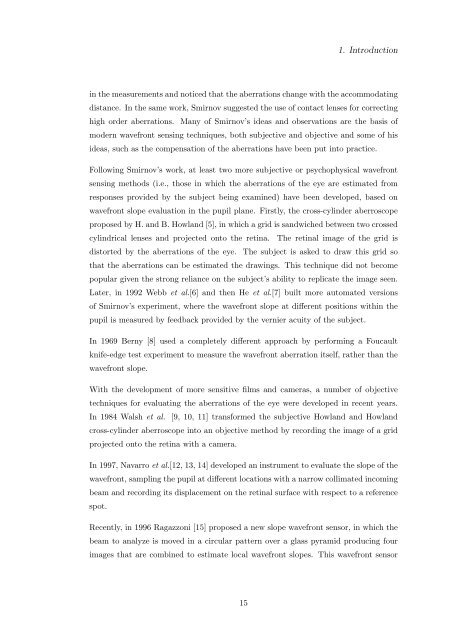Alfredo Dubra's PhD thesis - Imperial College London
Alfredo Dubra's PhD thesis - Imperial College London
Alfredo Dubra's PhD thesis - Imperial College London
Create successful ePaper yourself
Turn your PDF publications into a flip-book with our unique Google optimized e-Paper software.
1. Introduction<br />
in the measurements and noticed that the aberrations change with the accommodating<br />
distance. In the same work, Smirnov suggested the use of contact lenses for correcting<br />
high order aberrations. Many of Smirnov’s ideas and observations are the basis of<br />
modern wavefront sensing techniques, both subjective and objective and some of his<br />
ideas, such as the compensation of the aberrations have been put into practice.<br />
Following Smirnov’s work, at least two more subjective or psychophysical wavefront<br />
sensing methods (i.e., those in which the aberrations of the eye are estimated from<br />
responses provided by the subject being examined) have been developed, based on<br />
wavefront slope evaluation in the pupil plane. Firstly, the cross-cylinder aberroscope<br />
proposed by H. and B. Howland [5], in which a grid is sandwiched between two crossed<br />
cylindrical lenses and projected onto the retina. The retinal image of the grid is<br />
distorted by the aberrations of the eye. The subject is asked to draw this grid so<br />
that the aberrations can be estimated the drawings. This technique did not become<br />
popular given the strong reliance on the subject’s ability to replicate the image seen.<br />
Later, in 1992 Webb et al.[6] and then He et al.[7] built more automated versions<br />
of Smirnov’s experiment, where the wavefront slope at different positions within the<br />
pupil is measured by feedback provided by the vernier acuity of the subject.<br />
In 1969 Berny [8] used a completely different approach by performing a Foucault<br />
knife-edge test experiment to measure the wavefront aberration itself, rather than the<br />
wavefront slope.<br />
With the development of more sensitive films and cameras, a number of objective<br />
techniques for evaluating the aberrations of the eye were developed in recent years.<br />
In 1984 Walsh et al. [9, 10, 11] transformed the subjective Howland and Howland<br />
cross-cylinder aberroscope into an objective method by recording the image of a grid<br />
projected onto the retina with a camera.<br />
In 1997, Navarro et al.[12, 13, 14] developed an instrument to evaluate the slope of the<br />
wavefront, sampling the pupil at different locations with a narrow collimated incoming<br />
beam and recording its displacement on the retinal surface with respect to a reference<br />
spot.<br />
Recently, in 1996 Ragazzoni [15] proposed a new slope wavefront sensor, in which the<br />
beam to analyze is moved in a circular pattern over a glass pyramid producing four<br />
images that are combined to estimate local wavefront slopes. This wavefront sensor<br />
15

















